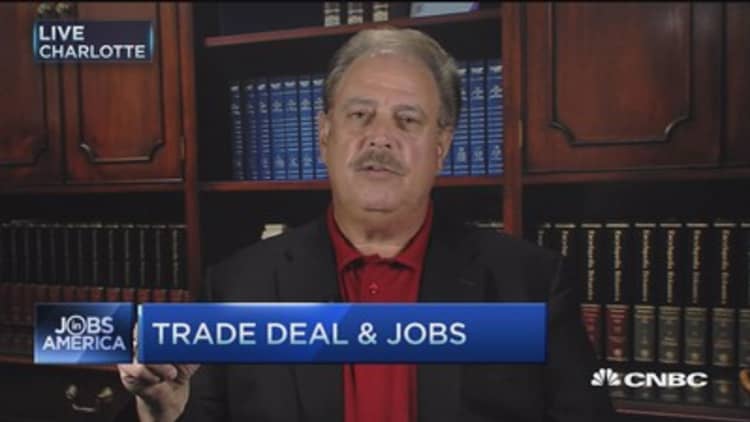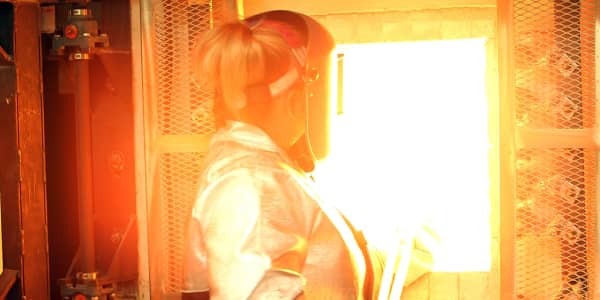
When it comes to the manufacturing sector in the U.S., it's not quite "Happy Days Are Here Again," as some have been singing for the past few years. Once you look closely at the data, it's more like "Those Were the Days."
That's because since the Great Recession, manufacturing is down 3.2 percent, according to an eye-opening report by the nonpartisan Information Technology and Innovation Foundation (ITIF). It notes there are now 15,000 fewer production facilities in the U.S. than in 2007—and 2 million fewer jobs.
A look at the numbers suggests that the rallying cry about a manufacturing renaissance has been wishful thinking among many industry trade groups and economists. Even favorable shifts in a host of factors, including labor costs, the shale gas boom, transportation costs and the weak U.S. dollar, hasn't revitalized the sector to its post glory days.
According to the National Association of Manufacturers (NAM), the industry trade group, federal policies on taxes, energy, regulations and competitiveness are what's holding back further growth. Right now the sector accounts for 12 percent of GDP and supports an estimated 17.6 million jobs.
"We're concerned about the overall decline of the manufacturing industry since around the turn of the century," said Adams Nager, an economic research analyst at ITIF and co-author with Robert Atkinson of "The Myth of America's Manufacturing Renaissance: The Real State of U.S. Manufacturing."
Read MoreThe 4-part plan to keep US manufacturing supreme
Much of the renaissance hype is tied to growth over the last four to five years since the Great Recession, which can be misleading, he added, because the trough was so deep. "We're seeing stable and slow recovery in demand, and that explains the growth in manufacturing, but that doesn't necessarily mean that growth will continue or that we're in a state of renaissance," Nager said.
The best measure of the health of manufacturing is real value added, Nager said. Since 2013, the most recent year data is available, that number was down 3.2 percent from 2007 levels—just prior to the recession—despite 5.6 percent GDP growth, he noted. "If you take out computers," a particularly strong sector, "we shrank 7.7 percent." What's more, the report said, there are still 2 million fewer jobs and 15,000 fewer manufacturing establishments than there were in 2007.
In February 2012, PricewaterhouseCoopers (PwC) released a study entitled, "Shale Gas: A Renaissance in U.S. Manufacturing?" It was among similar widely touted analyses of how the ongoing boom in natural gas—largely prompted by hydraulic fracturing, or fracking—was one of several key components that might lead to a surge in U.S. manufacturing and employment. Others were the low rate of the dollar, the high price of oil (then around $100 a barrel) and rising labor costs in China.
During the intervening three years, however, those trends haven't exactly panned out, as the ITIF's myth-busting report laid out:
- On Chinese labor: Chinese wages, while rising rapidly, are still estimated to be just 12 percent of average U.S. wages in 2015.
- On high global shipping costs: They're back to normal after falling by 93 percent in a six-month period in 2009.
- On the shale gas boom: That low-cost alternative to oil and coal has had a minor impact only on energy-intensive industries, such as petrochemicals and drilling operations.
- On currency valuation fixing the trade deficit: The dollar has risen sharply, yet our trade deficit persists. "We've consistently run a deficit since 1975, and we're no closer to seeing exports get anywhere near our imports," Nager said. "The idea that we can just wait it out is pretty dangerous."
- On U.S. productivity restoring jobs: Productivity isn't increasing faster than that of other industrialized countries, and it is growing much slower than China and South Korea.
"There certainly have been some headwinds in the last few years, but the fundamentals are still in place," said Bob McCutcheon, PwC's Industrial Products leader. For instance, the strength of the dollar bares both good and bad news. It's a sign of continuing economic growth in the U.S., despite the lingering trade deficit, McCutcheon offered. Likewise, the precipitous decline in oil prices "is a direct reflection of what's been going on in shale gas. It's the global response to our strengthening position in the energy sector."
We're seeing stable and slow recovery in demand, and that explains the growth in manufacturing, but that doesn't necessarily mean that growth will continue or that we're in a state of renaissance.Adams Nagereconomic research analyst at the Information Technology and Innovation Foundation
The resurgence in U.S. manufacturing is in fact a long-term prospect, McCutcheon clarified, and regardless of headwinds, certain sub-sectors, like energy, are doing better than others. Heavy-equipment, metals and chemicals, which benefit from being less labor-intensive, and lower energy costs, are relatively robust. He also points to advanced, disruptive technology—robotics, 3-D printing, the Internet of Things—as American strengths.
Read MoreCan the US win the robotics war on the factory floor?
"The global economy is evolving, and the U.S. is right in the epicenter of it all," opined Dave Blanchard, a senior editor at IndustryWeek, in sizing up America's current manufacturing stature. He addressed the ballyhooed promise of reshoring or near-shoring of jobs back to the U.S. from foreign sites. Reports of Apple, GE, Caterpillar and other major players reshoring some operations are feel-good anecdotes, he said.
And manufacturers could reduce supply-chain costs, like logistics, transportation and warehousing, by setting up shop in close-by, low-wage countries such as Mexico. But that's not going to make a dent in the nearly 5 million U.S. manufacturing jobs lost since 2000, he said.
The national skills shortage
Blanchard said that "the state of U.S. manufacturing in 2015 is relatively robust compared to where it had been over the previous decade," referring to the rebounded auto industry and the energy sector, and that increased use of robotics and other next-generation manufacturing technologies hold promise. In that latter vein, he joins a rising chorus of observers who insist that although the U.S. remains the world leader in R&D, training workers to use the technology is one of the greatest challenges for manufacturers.
Sridhar Kota is a professor of mechanical engineering at the University of Michigan and a board member of the coincidentally named Manufacturing Renaissance, a Chicago-based nonprofit champion of advanced manufacturing. He also served from 2009–12 in the White House Office of Science and Technology Policy, where he helped establish the Advanced Manufacturing Partnership and its signature Manufacturing Innovation Institutes.
"We need a plan for what to do with good ideas and how to mature them," he said, "to create the infrastructure, knowledge and skills so that ideas turn into products and the manufacturing sticks here, rather than invent it here and make it 'over there.'"
Read MoreWhy 'Made in USA' labeling is so complicated
He bemoaned the fact that R&D in the U.S. was responsible for the technology behind solar cells, lithium-ion batteries and flat-panel TVs, though we ceded production of those lucrative markets to overseas manufacturers.
Getting back our mojo
"Those ships have sailed, and they're not coming back," he said. But what about next-generation technologies we're working on now, such as flexible electronics, nanocellulose and self-driving cars? "We can't let Asia pick them up," he said, advocating for more public-private R&D partnerships. "When new technology is emerging, you want R&D and manufacturing to be co-located."
Kota agrees with NAM and other manufacturing boosters that to spur existing industries, the U.S. needs to make them more competitive through reforms of the tax code, free trade and regulations. Echoing that sentiment is Deborah Wince-Smith, president and CEO of the Council on Competitiveness in Washington, D.C. The non-partisan council supports manufacturing competitiveness through innovation, but is critical of what Wince-Smith said is "our very innovation-hostile capital cost structure and regulatory environment in the U.S. that's impeding many of these things," especially advanced manufacturing.
She, too, calls for new models of public-private partnerships to foster R&D. Toward that effort, this week the council will announce a new initiative, Exploring Innovation Frontiers, a 10-year program integrating energy and manufacturing productivity.
"We continue to be an innovation game-changer in many areas," Wince-Smith said, "but it can't just be in software and communications. We still have to make things, because we live in a physical world."
—By Bob Woods, special to CNBC.com




